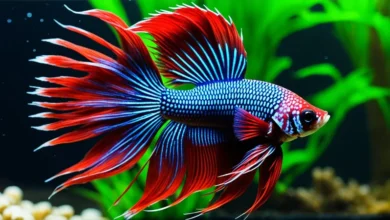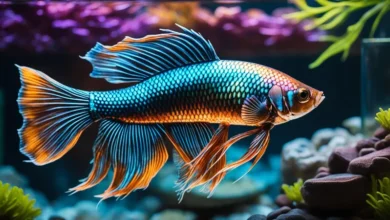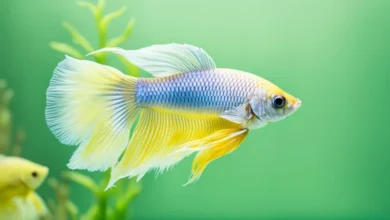
The Siamese Fighting Fish, also known as Betta splendens, is a popular choice among aquarium enthusiasts due to its vibrant colors and diverse morphological variations. Originating from Southeast Asia, including countries like Thailand, Indonesia, and Vietnam, this freshwater fish has a long history of selective breeding. As a result, there is an astonishing variety of Siamese Fighting Fish varieties, each showcasing its unique beauty.
The Origin and Domestication of Siamese Fighting Fish
The Siamese Fighting Fish, also known as Betta splendens, have a rich history of domestication that dates back over a thousand years. Originating in Thailand, these fish were initially bred for their aggressive nature and used in gambling matches reminiscent of cockfighting. Betta splendens quickly gained popularity beyond Thailand’s borders when King Rama III presented some specimens to Theodore Cantor, a Danish physician, zoologist, and botanist.
By the late 19th century, Siamese Fighting Fish had made their way into the Western world, captivating fish enthusiasts with their vibrant colors and unique characteristics. They became highly sought-after as ornamental fish, admired not only for their territorial behavior but also for their stunning appearance.
The domestication of Siamese Fighting Fish has played a significant role in the development of various Betta varieties. Skilled breeders have selectively bred these fish, resulting in an incredible range of colors, fin shapes, and patterns that are now synonymous with the species. Today, Betta splendens continue to fascinate aquarists worldwide with their beauty and captivating displays.
Siamese Fighting Fish have a remarkable history of domestication and evolution as a result of human influence on their breeding. From their humble beginnings in Thailand to their widespread popularity today, the journey of Betta splendens as a domesticated species is a testament to the captivating nature of these remarkable creatures.
Diversity and Coloration in Siamese Fighting Fish
The selective breeding of Siamese Fighting Fish, also known as Betta splendens, has resulted in a mesmerizing range of vibrant colors and distinct fin types. While wild Bettas typically display dull and drab coloration, captive-bred males showcase dazzling hues of red, blue, and green. The coloration of these fish is truly a feast for the eyes.
The top layer of color in the Betta’s scales is typically blue, followed by intricate combinations of red, black, and yellow. These intricate color patterns create a stunning visual spectacle in aquariums.
Aside from their captivating coloration, Siamese Fighting Fish also exhibit a wide variety of finnage. Each fin type presents a unique and beautiful silhouette, adding to the allure of these fish. Some popular finnage varieties include:
- Veiltail: Known for its long and flowing fins, the Veiltail variety is a classic choice for Betta enthusiasts.
- Halfmoon: Characterized by its expansive, semi-circular tail, the Halfmoon variety creates a stunning display when fully spread.
- Crowntail: With its spiked and serrated rays, the Crowntail variety adds an exotic touch to any aquarium.
- Plakat: The Plakat variety features short and compact fins, making it an active and agile swimmer.
The vast array of color variations and fin types in Siamese Fighting Fish makes them a favorite among aquarium enthusiasts and collectors. Whether you prefer bright and bold colors or elegant fin shapes, there is a Betta variety to suit every aquarist’s preference.
Behavior and Territoriality in Siamese Fighting Fish
Siamese Fighting Fish, particularly males, exhibit highly territorial behavior. These magnificent fish are known for their aggressive nature, often engaging in skirmishes with other males. Such encounters can sometimes escalate into fierce battles, resulting in injury or even death for one or both combatants. Female Betta fish also display territorial tendencies, especially when confined to small spaces.

When keeping multiple Siamese Fighting Fish, it is crucial to provide ample space and separation to minimize aggression. Each fish should have its own territory to establish dominance and reduce the likelihood of conflicts. A spacious tank with plenty of hiding spots and visual barriers can help create separate domains, promoting a more peaceful coexistence among these vibrant aquatic creatures.
The territorial behavior of Siamese Fighting Fish is a natural instinct deeply ingrained in their genetic makeup. It is essential for fishkeepers to understand and respect this aspect of their behavior to ensure a harmonious and stress-free environment.
Marine Aquatics
To mitigate territorial conflicts, consider dividing the tank into sections using vegetation, rocks, or decorative elements. This can create distinct territories and provide a semblance of privacy for each fish. Additionally, regular monitoring of the fish’s behavior and immediate intervention in case of aggression can help prevent serious fights.
Signs of Territorial Aggression:
- Flaring fins and gills.
- Intense chasing and nipping.
- Displaying vibrant colors.
- Building bubble nests (males)
Understanding the territorial nature of Siamese Fighting Fish is crucial for ensuring their well-being in captivity. By providing appropriate living conditions and monitoring their behavior, fishkeepers can promote a peaceful and harmonious environment for these captivating aquatic pets.
Unique Adaptations of Siamese Fighting Fish
Siamese Fighting Fish, also known as Betta splendens, possess unique adaptations that allow them to thrive in low oxygen environments. One of their remarkable adaptations is the presence of a specialized organ called the labyrinth organ.
The labyrinth organ enables Siamese Fighting Fish to breathe air from the surface in addition to their gill respiration. This adaptation is particularly essential in low oxygen levels and poor water quality conditions, as the fish can supplement their oxygen intake by gulping air. By extracting oxygen from the air, Siamese Fighting Fish can survive in environments where other fish species would struggle.

It is fascinating to note that Siamese Fighting Fish are relatively resilient and can tolerate a wide range of water conditions. This adaptability makes them suitable for beginner aquarists who may not have as much experience in maintaining precise water parameters.
Global Popularity and Conservation of Siamese Fighting Fish
Siamese Fighting Fish, particularly Betta splendens, have gained worldwide popularity as pets and aquarium fish, making them one of the most sought-after species in the trade. Their vibrant colors and unique finnage have captured the hearts of aquarium enthusiasts around the globe.
Thailand, the native country of Siamese Fighting Fish, remains the primary breeder and exporter of Bettas for the global market. The country’s rich history and expertise in Betta breeding have contributed to the global popularity of these captivating fish.
However, despite their abundance in captivity, wild Siamese Fighting Fish populations face significant threats. Habitat destruction, pollution, and the expansion of palm oil plantations pose significant challenges to the survival of Betta splendens in their natural habitats.
The Siamese Fighting Fish’s conservation status is of great concern due to the declining populations in the wild. Urgent action is needed to protect their fragile habitats and ensure the long-term sustainability of this iconic species.
Dr. Maria Rodriguez, Fish Biologist
As a result of these threats, Betta splendens is now listed as “vulnerable” on the IUCN Red List, indicating a high risk of endangerment in the near future. Conservation efforts are crucial to safeguard the wild Siamese Fighting Fish populations and preserve their natural beauty for future generations to appreciate.
Feeding Habits and Care of Siamese Fighting Fish
Siamese Fighting Fish, also known as Betta splendens, are carnivorous creatures. In their natural habitat, they primarily feed on zooplankton, small crustaceans, and insect larvae. When kept in captivity, it is important to provide them with a varied diet that closely mimics their natural feeding habits.
One way to achieve this is by offering them a combination of high-quality pellets, flakes, and frozen foods such as brine shrimp and bloodworms. These food options will help ensure their nutritional needs are met. However, it is crucial to note that Siamese Fighting Fish have a limited ability to process carbohydrates. Therefore, their diet should consist mostly of animal protein.
Proper care for Siamese Fighting Fish extends beyond their nutrition. Providing them with a suitable tank size is essential to support their overall well-being. A tank size of at least 5 gallons (19 liters) is recommended to allow them space to swim and explore. Additionally, maintaining water cleanliness is crucial. Regular water changes and the use of a high-quality filtration system will help keep their environment clean and free of toxins.
Optimal water conditions are also essential for the health of Siamese Fighting Fish. They prefer water temperatures between 76°F and 82°F (24°C to 28°C) and a slightly acidic to neutral pH level of 6.5 to 7.5. Monitoring water parameters regularly and making necessary adjustments will help ensure their well-being.
Remember, providing proper care and meeting their feeding requirements are crucial to the health and longevity of Siamese Fighting Fish. By understanding their natural feeding habits and creating a suitable environment, you can enjoy the beauty of these captivating fish in your aquarium for years to come.
Conclusion
Siamese Fighting Fish, also known as Betta splendens, are a captivating choice for aquarium enthusiasts. With their stunning color variations and diverse finnage, these fish showcase the true beauty of the species. The domestication and selective breeding of Betta splendens have resulted in a wide range of varieties, making them a popular and sought-after species among aquarists.
However, it is crucial to provide proper care and appropriate living conditions for Siamese Fighting Fish to ensure their well-being. These fish require suitable tank sizes, clean water, and optimal conditions to thrive. Additionally, a varied diet consisting of animal protein is essential for their nutritional needs.
Despite their popularity in captivity, wild populations of Siamese Fighting Fish are facing ongoing threats, including habitat destruction and pollution. Conservation efforts are necessary to protect their natural habitats and preserve these beautiful creatures for future generations. Betta splendens, with its vibrancy and unique characteristics, will continue to enchant aquarium enthusiasts as one of the most captivating and alluring aquarium fish varieties.



